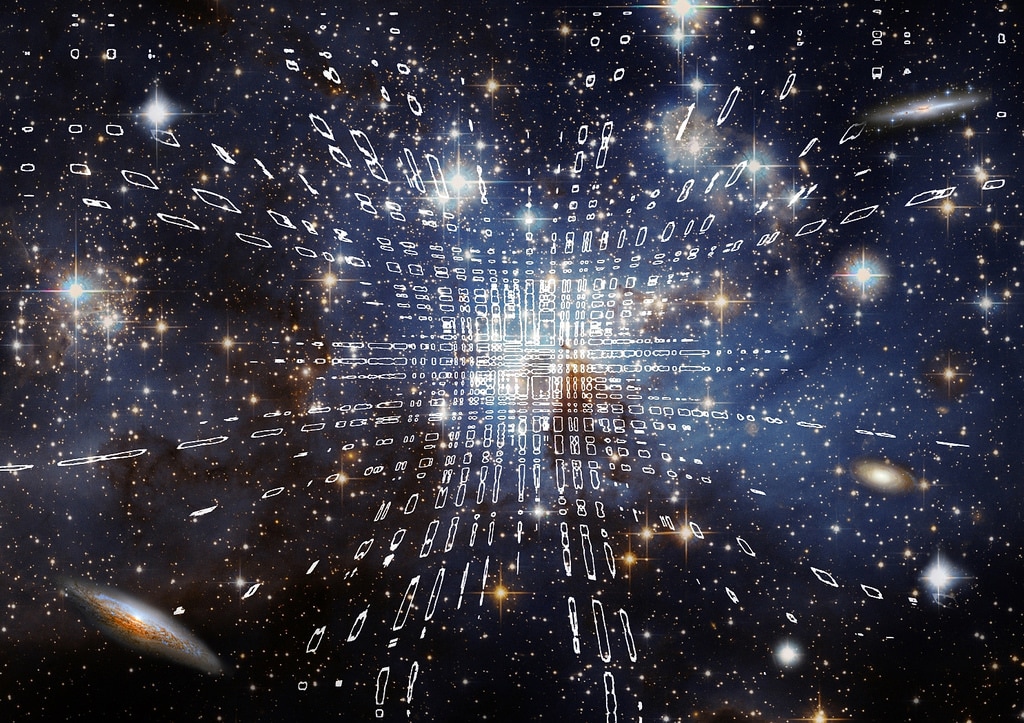How come we are condensed into a single point of the Universe? Is there another way of existing in it? Is there a way of experiencing the reality without being so restrained into this point of space-time? Is there any other kind of existence at all?
These existential questions can lead us to ask ourselves the very basic one: who am I? Or what am I? Or even am I? In order to get a glimpse at the final answers to these questions, we must be very thorough in our self-inquiry. We also have to rely not only to thoughts and logical thinking (which indeed may help a lot), but primarily to try to work honestly on ourselves, and directly experience the Truth. Inquiry begins The first point of our inquiry on the fabric of our individual reality is the question about its roots. Our perception of the world is based on witnessing it from the usual point of view, the sense of “I-ness.” We feel our blurred sense of “I” as opposed to everything else, the “no-I.” It is obvious that all our experiences stem from this basic dichotomy: I – everything else. We have countless perceptions about the external world and our own being: thoughts, emotions and 5 “usual” senses. We can call them the contents of mind, and the whole outer reality is being perceived through these three kinds of mind content. Underlying reality The First postulate of the Reintegration System claims: “There exists an underlying, supremely perfect reality, independent of time and space, yet subtly present in all phenomena.” However, we might choose certain words in an attempt to describe this reality, like God, Being, Source, Tao, Sunyata, Emptiness, Void, Nothingness, Wholeness, Oneness, and so on; yet all those terms will be far from being adequate for depicting the supreme reality. It is worth noting that there are several concepts in modern physics that symbolically represent this underlying reality or point to it. In Einstein’s Theory of relativity, it is the space-time continuum. In quantum physics, it’s the quantum vacuum. Also, in various works of the late American theoretical physicists David Bohm, this reality is clearly named as the implicate order. Oneness Nevertheless, this reality is definitely the source of everything. Although it has no inherent attributes, we can still designate some characteristics to it, from our limited point of view. And, one of the most obvious characteristics would be oneness. It’s undivided and undividable. Consequently, if this oneness is the primal source of the whole reality, then all seemingly separate entities or things are, at the deepest level, an illusion. If we accept this, then the next obvious thing is: our internal world and external reality are also inseparable. They are one. There is a subtle, yet fundamental, oneness of inner and outer reality. In a delicate way, they are equal. Whatever is inside, the same is outside, and vice versa. Holographic principle Of course, as we are identified with this illusion and heavily covered by countless veils of ignorance, we are not aware of that sameness of inner and outer world. Nevertheless, that sameness must be expressed in some way. That is the holographic principle. Basically, it says that each part of an entity contains complete information on the whole entity. Accordingly, within every human being, as a part of the Universe, there is complete information about the Universe. Similarly, the same correlation is between one’s inner and outer reality.
It seems that modern science is also going toward the holographic idea. A lot of groundbreaking research has been done in the last couple of decades in the fields of neurology and psychology, showing striking correspondence with holographic principle, especially related to memory and other functions of the human brain. For example, neuroscientist Karl Pribram, initially in collaboration with physicist David Bohm, developed the holonomic brain theory. It is a model of human cognition that describes the brain as a holographic storage network. “Pribram and others noted the similarities between an optical hologram and memory storage in the human brain. According to the holonomic brain theory, memories are stored within certain general regions, but stored non-locally within those regions.”[i]
The holographic model is also emerging in theoretical physics. “The holographic principle is a property of string theories and a supposed property of quantum gravity that states that the description of a volume of space can be thought of as encoded on a lower-dimensional boundary to the region—preferably a light-like boundary like a gravitational horizon.”[ii] This implies an astonishing idea that the entire 3D universe is a kind of a projection of the information embedded in the cosmological 2D horizon. Veils of ignorance What are these veils of ignorance, causing our total immersion into this illusion? Basically, they are our misperceptions or unawareness of various layers of Reality. They are directly connected to our identifications, beliefs and other elements of personality described in the Reintegration System. We think we are something else than we truly are. In fact, whatever we think we are, we are wrong. It can only be that we are, as opposed to the notion that we are something or someone. Every single identification contributes a little bit to our immersion in this world of illusion. For example, a person acts as a sister. From the point of view of that identity, the person behaves differently than from the genuine state of Presence and from all her other identities. Her behavior is limited to her traumas from the past, to her fears for her “little” brother or sister, desires for being protective, or better than her siblings, beliefs on being superior or inferior, etc. All those habitual notions or traits seriously confine her genuine abilities and perfection of acting from Presence. After all, those notions deeply limit her perception of reality. Game of life rules Why do these veils of ignorance exist whatsoever? The explanation of this mystery lies in being’s primal decision to have experiences. Quite obviously, in order to bring any experience into existence, a basic polarity should be established: the “experiencer” and that which is being experienced, we will name it the “experienced.” Therefore, the primal Being must seemingly split itself up into those two polarities. It actually “condenses” itself into a limited region or point, which is conscious of the outer region “around” it. In a sense, the Being deliberately “retreats” from the “rest” of it, the “outer world.” The external world becomes the “unknown,” a field of unconsciousness.
There should also exist “something” in which the experiencer and the experienced exist. It is space. But, that is still not enough, as this polarity in space is totally static. If there should be some experience, there must be some dynamic events. The Being must introduce time.
Now, what is time? In relativistic physics, it is simply one of the dimensions within the four-dimensional continuum called space-time. So, in space-time there are four coordinates assigned to an event. For example, if you wanted to describe the very basics of the event when you eat an ice-cream last time, you would have to assign three coordinates of space to it. It happened in a point of space that had its precise longitude, latitude and altitude. But, that’s not enough. It must have an additional value: the time when it happened. Thus, it is described by four coordinates. Modern physics tells us that these four coordinates are inter-changeable. They are equivalent. So, when we have a series of mutually connected events, like moving a car from point A to point B, we actually have countless mini-events, each being described with its own four coordinates in the space-time continuum. And when we have a non-moving car on a parking slot, it seems that we now have a completely static situation. No, it’s not. It is still moving, through the fourth space-time coordinate, through time. Now, note this: as an observer of that seemingly static car, you are also moving through the fourth dimension – time. From a deeper point of view, the only entity that is moving along this fourth dimension is the observer, you. Therefore, a conscious observer, or the experiencer, must move along one of the coordinates of the four-dimensional continuum, in order to get an impression of a dynamic experience. We now have established some rules for the game of life. Nevertheless, this is not enough for a complete picture. That moving through one of the dimensions must be unconscious, otherwise the experiencer would have been able to manipulate with the experience at their will, with no effort. Moreover, they shouldn’t be conscious of any of the following events – the future must be under the veil of the unknown in order to have the possibility of wonder. Also, their memories from the past should be vague and more or less unreliable – otherwise they would have a perfect basis for a perfect behavior, and that also wouldn’t be good for the game. However, those memories have to be mutually consistent and interconnected, in order to form a unique personality with their own unique desires, fears, beliefs, etc. Interactions between the players can begin now. They are all imperfect, as well as the environment itself. Countless experiences can arise now. The bottom-line of the life game is to have plenty of imperfections at the stage. In that way, there will also be plenty of room for making mistakes, learning valuable lessons and ultimately, for expanding the growth of the consciousness and spirituality. And the final target for all players is the same – to re-unite with God, as fully conscious beings. Conclusion In order to have any experiences in life, there should be set up several pre-conditions, as following: - There must exist the primal polarity: I (“experiencer”) – no-I (“experienced”); - We must be moving forward along the time coordinate within four-dimensional space-time, from the past to future; - We must not know the future occurrences; - We should not have totally reliable memories of the past; - We should have a continuity of the memory. As we have all the basic pre-conditions for the game of life now, we can have various experiences that we can learn from and grow. After all, that is the purpose of this game of life. As the individual's reality becomes imperfect, due to veils of ignorance, within the individual arise inclinations and aversions. Essentially, the being wants to return to their original state – happiness. If the inclinations and aversions are not satisfied, the individual suffers. So, if we want to deliver ourselves from suffering, we must release our desires and fears, habits, emotions, thoughts, and many other parts of our personality. The best way to do that is to reintegrate them in a non-aggressive, benevolent way. Some of the new approaches to doing this in a comprehensive and efficient, yet elegant way, are the Reintegration System techniques. Still, the basic pre-condition for suffering is ignorance. We may reintegrate the whole inner galaxy of personality’s elements, but if these veils of ignorance remain, we would suffer time and again, as they would repeatedly generate fears, desires and all other variations of personality elements. Luckily, these veils are usually being released spontaneously, through the reintegration of various elements of personality, layer by layer. And if they are not released – no problem, we just treat them with the Reintegration techniques like all other elements of personality. If we are uncertain which element to deal with, we just have to look around us – the outer world is a projection of our inner universe. The holographic principle will impeccably lead us along this path. As our work continues, our consciousness will be expanding, while unconscious limitations are being dropped away progressively. The reintegration work will be resembling the art more and more, as the mystery of life unfolds in most surprising and beautiful ways. [i]https://en.wikipedia.org/wiki/Holonomic_brain_theory [ii]https://en.wikipedia.org/wiki/Holographic_principle
0 Comments
|
Please note that most of the articles have a "Read More" break, which is sometimes hardly visible.
It is located at the bottom of visible part of the article, on the right side. To continue reading the article, click on that link. This page may contain affiliate links meaning we earn a commission if you use those links.
We only recommend pages we appreciate and trust. Archives
March 2023
Categories
All

|
For guest posts or placing ads on our website, please use the contact form on the 'About/Contact Us' page.





 RSS Feed
RSS Feed

